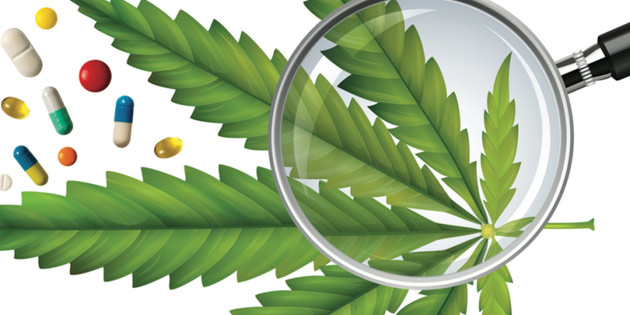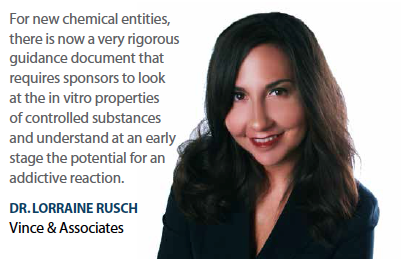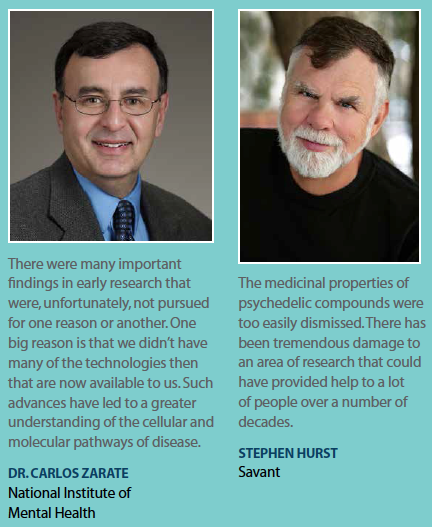 The broad reaching war on drugs that began more than 40 years ago had an unintended consequence: research on the therapeutic value of controlled substances such marijuana, psychedelics, narcotics, and stimulants stalled. Controlled substances were difficult for researchers to get and research was often surrounded by controversy.
The broad reaching war on drugs that began more than 40 years ago had an unintended consequence: research on the therapeutic value of controlled substances such marijuana, psychedelics, narcotics, and stimulants stalled. Controlled substances were difficult for researchers to get and research was often surrounded by controversy.
But this mindset is changing, and there is a revival of interest in these compounds. In the last five years, there has been greater interest at both the academic and industry levels to understand the cellular and molecular levels of neurology diseases. This is creating new interest in trying to understand the medical benefits that controlled substances can provide. The campaign for medicinal marijuana helped to shed light on these compounds.
“The medicinal properties of psychedelic compounds were too easily dismissed," says Stephen Hurst, founder and CEO of Savant HWP. “There has been tremendous damage to an area of research that could have provided help to a lot of people over a number of decades. A lot of this was political, a lot of it was a lack of information, a lot of it was one generation reacting to the behavior of another generation."
The notion of psychedelic medicine is controversial, Mr. Hurst says. But psychedelic drugs were frequently used in clinical research until they became classified as Schedule 1 drugs by the Drug Enforcement Agency. This agency was created after Congress passed the Controlled Substances Act in 1970. This created a “schedule" or class based on their potential for abuse and medical benefits.
Almost immediately after the passage of this law, there were efforts to change it. For example, marijuana is a schedule 1 drug despite studies done on its medical benefits for treating pain, reducing nausea during chemotherapy, stimulating appetite, easing muscle spasticity, and easing anxiety. Synthetic cannabinoid products on the market include: AbbVie’s Marino; approved in the United States for loss of appetite in AIDS patients and for managing nausea in cancer patients; Meda’s Cesamet, approved in the United States for nausea and vomiting caused by chemotherapy; and GW Pharmaceuticals Sativex, approved in the UK for symptoms of multiple sclerosis.
 New imaging technologies and new ways to map the connections of neurons are providing new insights into how the brain works. At the basic research level, new efforts for understanding the brain were sparked in part by President Obama’s Brain Research through Advancing Innovative Neurotechnologies (BRAIN) Initiative. Launched in April 2013, the initiative is a coordinated effort among public and private institutions to add to our understanding of the human brain.
New imaging technologies and new ways to map the connections of neurons are providing new insights into how the brain works. At the basic research level, new efforts for understanding the brain were sparked in part by President Obama’s Brain Research through Advancing Innovative Neurotechnologies (BRAIN) Initiative. Launched in April 2013, the initiative is a coordinated effort among public and private institutions to add to our understanding of the human brain.
Research of Hallucinogens
There has been decades of research at the National Institutes of Health as well as at academic institutions such as Johns Hopkins, Mount Sinai, and New York University, which are looking at psychedelics and hallucinogens such as ketamine, ibogaine, and psilocybin.
The National Institutes of Health, for example, has been studying ketamine for use as an antidepressant. Ketamine is a dissociative anesthetic, mostly used in veterinary practice. It distorts perceptions of sight and sound and produces feelings of detachment from the environment and the body. Ketamine acts on the glutamate receptor (NMDA receptor) to produce its effects. At high doses, ketamine can cause dreamlike states and hallucinations and can impair motor function, raise blood pressure, and produce respiratory problems.
Unlike current antidepressants, which can take weeks to work, ketamine-like drugs have an immediate effect. They also have helped people with depression who didn’t respond to other medications.
Early research of current therapies show that the effects on serotonin or norepinephrine were just the first steps in a cascade of events that ultimately brought about changes in the NMDA receptor.
“We need new drug targets," says Carlos Zarate, M.D., chief, section on the neurobiology and treatment of mood disorders and chief of Experimental Therapeutics and Pathophysiology Branch at the National Institute of Mental Health, who has been studying the effects of ketamine, a glutamatergic modulatory, for more than 10 years.
“Only about one-third of our patients do very well with one course of a current antidepressant," he says. “It usually takes two antidepressants or six months for half of the people to achieve remission. During this lag, there can be significant symptoms, functional impairment, and disruption to our patients lives. There is also the risk of suicidal behavior until the full antidepressant effect takes place."
 In Dr. Zarate’s studies at the NIMH, they studied ketamine in individuals who had been treatment resistant. In fact, most of the patient had failed an average of seven antidepressants and 60% had failed electroconvulsive therapy, which is one of the most effective treatments for depression. Additionally 50% of the patients who participated in the ketamine studies had previous suicide attempts.
In Dr. Zarate’s studies at the NIMH, they studied ketamine in individuals who had been treatment resistant. In fact, most of the patient had failed an average of seven antidepressants and 60% had failed electroconvulsive therapy, which is one of the most effective treatments for depression. Additionally 50% of the patients who participated in the ketamine studies had previous suicide attempts.
Ketamine is a game changer, and we can learn quite a bit about it to identify new drug targets that will lead to better treatments, Dr. Zarate says.
“What is quite remarkable about ketamine is that one infusion of it produces an onset of antidepressant action within just a few hours," he says. “Most of the studies to date with ketamine have generally been small studies, however, the results have been very consistent from study to study. The time course of antidepressant action is quite similar across studies, indicating that the targets on where ketamine acts are responsible for achieving rapid antidepressant action. We are truly modifying relevant therapeutic targets."
The NIMH’s work in ketamine has sparked interest at multiple levels, including academia, government, and industry to develop ketamine-like molecules.
One company working in this area is Janssen. The company’s intranasal esketamine, a chemical variant of ketamine that has been designated a breakthrough therapy by the Food and Drug Administration, has begun Phase III trials. Esketamine is being studied for treatment-resistant depression.
“Our objective — and I was involved in some of the original studies at the NIH at the time — was to find a safe NMDA receptor antagonist that crossed the blood-brain barrier," says Husseini Manji, M.D., global therapeutic area head of neuroscience, at Janssen. “Based on years of preclinical research, we specifically wanted to target this receptor. The fact that the compound happened to be a controlled substance was incidental. Our strategy has been to identify the most relevant molecules that are involved and target them in the best way."
Dr. Manji says there is a tremendous unmet need in this area.
“Treatment-resistant depression really takes a toll on people," he says. “Today’s treatments have the same mechanism. People often try one treatment and if it doesn’t work in six weeks to eight weeks, they will switch to another one."
Ketamine has been shown to directly impact the NMDA receptor and often quickly.
“Studies of IV ketamine were undertaken in patients who had failed six different antidepressants," Dr. Manji says. “The patients, who had been continually depressed for three years responded within hours. Within 24 hours, 70% of them met criteria for response. This is why we chose the NMDA receptor as our target."
Anti-Addiction Research
Another avenue of research is addressing addiction. Savant is conducting Phase I studies of 18-MC as a treatment for many forms of addiction and compulsive behavior, with an initial focus on cocaine and opiate dependencies. This compound is derived from ibogaine, a naturally occurring psychoactive substance found in plants. Ibogaine was demonstrated to have anti-addictive properties about 50 years ago but because it is a potent hallucinogen and it may also induce cardiac arrhythmias, it is a Schedule 1 compound in the United States.
Savant’s compound appears to retain the anti-additive properties of ibogaine while eliminating the undesirable side effects of hallucination and potential cardiac arrhythmias.
“The first in-human study that we did without seeing any psychoactive component in healthy volunteers is an important milestone because it suggests the medicinal chemistry program did in fact succeed in eliminating the least desirable of the side effects," Mr. Hurst says. “We are cautiously optimistic about where we are going. We believe the medicinal chemistry program may well have been successful in eliminating the side effects while maintaining the anti-addictive properties."
18-MC is a nicotinic receptor antagonist that regulates dopamine fluctuations in the brain. This mechanism of action differs from all current medications used to treat addiction that are either agonists or antagonists for the addiction substance’s primary receptor site. Data from animal models have shown 18-MC efficacy in a broad array of substance addictions, including cocaine, opiate, methamphetamine, nicotine, and alcohol.
“Rather than be like an on/off switch for dopamine, it seems to behave more like a governor on a motor that won’t let something go below or above a certain number of RPMs," Mr. Hurst says.
Mr. Hurst says 18-MC works not on dopamine but on a parallel reward pathway in the mid-brain.
“Addiction is caused by the dysregulation of dopamine in the pleasure centers of the brain," he says. “This is the primitive part of the brain that is designed to override reason. Dopamine is our well-being pleasure drug. It’s related to satisfaction with food, company, sexual gratification, even gambling. It’s all driven by dopamine in the pleasure center in the mid-brain."
He says 18-MC appears to reestablish dopamine regulation.
Research Challenges
Research of controlled substances involves additional oversight. This can add to the complexity and costs of trials, says Lorraine Rusch, Ph.D., VP of Vince & Associates.
“These are not insignificant budgets," she says. “A lot of that centers around the fact that a controlled substance is being administered to a person who is becoming impaired. The patient’s response has to be monitored while in an impaired state. These trials require extra medical support."
The FDA and NIDA, she says, have led the way in helping the industry understand what the side effects of these drugs are before they are approved. Dr. Rusch says work in this area has increased because of recent guidances from the FDA regarding potential for abuse of scheduled products.
For new chemical entities, there is now a rigorous guidance document that requires sponsors to look at the in vitro properties of controlled substances and understand at an early stage the potential for an addictive reaction.
“We are fully staffed with paramedics on site who work along with the principal investigator who often has a psych background," she says. “These professionals are highly trained and the research staff and nursing personnel all have floor experience."
At Janssen, Dr. Manji says the trials for intranasal esketamine are being conducted in clinical settings, and if the product is approved it would be administered in clinics or doctors’ offices.
“One side effect is perceptual abnormalities that can happen within 45 minutes of receiving the drug and is short lived," he says. “In high doses, some people can have psychotic symptoms. But that is not something we generally see at our doses. Some people can also have a transient increase in blood pressure."
Janssen’s data suggests there is an induction phase and maintenance phase. For the first four weeks, patients would come to the clinic twice a week to receive the treatment. After those four weeks, patients can be maintained with infrequent dosing. (PV)


















